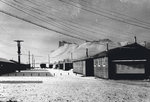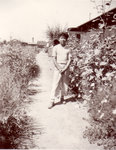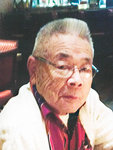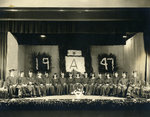



Editor’s Note: The following is an excerpt from Julie McDonald Zander’s book “Life on the Home Front.” The book was published in 2005, and some of the individuals included have since died.
John Sato was born in Chehalis in March 1933 and grew up on a farm in Adna. But unlike his Lewis County neighbors, John Sato spent more than three years behind barbed wire in a prison camp, where he watched his little sister come into the world and his mother leave it.
He is a Japanese-American who had what he described as a rather ordinary childhood.
“I grew up on a truck farm,” Sato said. “We raised a variety of vegetables, which we harvested and loaded onto a truck and sold to markets in the Centralia and Chehalis area.”
The youngest of four children, John helped his parents on the farm with chores and attended Adna Grade School.
At that time, in the late 1930s, the family consisted of his parents, Tom and Hanako, or “Hana,” Sato, who immigrated to Seattle from Japan, and their children: Toshiko, Eddie, Amy and John. Then in 1940, the couple had a fifth child, Irene.
Sometime after Amy’s birth in 1931, the family moved south to Lewis County to help run the family farm after Hana’s parents died. Her brother, Ted Ohi, was already living at the farm.
In fact, he owned it. That’s because federal law prohibited “alien residents,” or anyone born in Japan, from owning land in the United States. So Hana’s parents, who had been born in Japan, put the ownership of the farm in the name of their son, Ted, who had been born in America.
“He was an American citizen so he was able to own property,” Sato said.
John Sato’s maternal grandparents had moved to a small community called Littell east of Adna years earlier to work in a sawmill.
“They were able to purchase this little farm,” Sato said. “They put it in my uncle’s name because at that time they couldn’t put it in their own name.
“I would guess the farm was a typical small farm for that period — raising vegetables for market, 15 milk cows, a hundred or so chickens, couple of pigs, etc.”
The entire family pitched in to help with chores, planting seeds, harvesting crops and tending animals. The children all attended Adna schools. Then the Japanese attacked Pearl Harbor Dec. 7, 1941.
“Well, I was in the third grade when the war broke out,” Sato recalled. “When the war broke out, we were all relocated to those camps.”
President Franklin D. Roosevelt issued Executive Order 9066 Feb. 19, 1942, caving to political pressure, war hysteria and racists who called for the incarceration of all Japanese-Americans on the West Coast (2017 was the 75th Anniversary of the order.) The order authorized the internment of more than a hundred thousand American citizens of Japanese ancestry and resident aliens from Japan.
Immediately after the attack on Pearl Harbor, the government demanded that all Japanese Americans turn in their radios, guns, flashlights and other items.
“Very shortly after Pearl Harbor, we were put on curfew — daylight to dusk — limited to travel in a 5-mile area,” Sato said.
Since it wasn’t harvesting season, the family didn’t need to drive to Centralia or Chehalis — except to turn in their personal property to the Lewis County sheriff.
“We finished the school year and shortly after, we loaded on a train that took us to the camp. We went directly to Tule Lake, California.”
Packing to leave — without knowing how long they’d be gone — each could bring only what they could carry in a suitcase, primarily winter clothing. They boarded a three-car passenger train at Chehalis, along with Japanese-Americans from Raymond and South Bend. It was John Sato’s first train ride —a ride that lasted several days.
“But it seemed to take forever to get to the destination. Spent more time sitting on railroad siding than moving. That was because the freight trains had the priority because of the war effort.”
While he didn’t see any guards on the train, he found them posted at the perimeter of his new home — Tule Lake, California, an incarceration camp featuring rows of wooden barracks encircled with barbed wire fence and armed guards in towers overlooking everyone.
“There were guards but within a very short time the guards disappeared since it was unnecessary. Because, you know, we weren’t going anywhere,” Sato said. “I mean that the people who had been incarcerated weren’t enemies to this country and were doing exactly what they were asked to do. Boys of draft age were drafted and served in the Army. However, most of them volunteered to serve.”
As a child, he didn’t know exactly how his parents felt about the entire ordeal. “Well, no one was happy about it,” he said. “But what could you do?”
The family didn’t even have any close relatives in Japan — only Tom Sato’s half-sister, “but they weren’t that close,” Sato said.
“Living conditions in those camps were pretty dismal,” Sato said. “The living barracks were as minimal as you can get. Floors were diagonal tongue and groove boards. The walls were open studs with diagonal shiplap overlaid with building paper.”
The Satos crowded into one end of a barrack, which they shared with at least three other families. For privacy, they hung blankets. If the wind blew over the barren and desolate land, dust poured through the cracks and into the barracks.
“The space we were given was approximately 20 feet by 30 feet. Just a guess. And that was for a family including a mother, father and five children.”
His uncle lived in another area. Everyone slept on Army cots, covered with Army blankets.
“All bathrooms facilities were in another building. In our case we had to walk 30 yards or more,” Sato said.
Although his parents didn’t speak much about the relocation to a camp, Sato said, “I’m convinced that they weren’t happy. They were bewildered.”
Just over a year after entering the camp, Hanako Sato gave birth to a little girl, Jane, whom everyone called Janie. Six weeks later, Hana passed away.
John was ten.
“We had no real hospital — a makeshift building with staffed doctors who also were interned in to the camps,” Sato said. “Well, we really aren’t certain of her illness. After our layman’s description of her condition, my son, who is a doctor, has come to the conclusion it must have been some form of cancer. It probably wasn’t a heart condition. Those days if it were cancer, I don’t know what they could have done. You know, there was no diagnosis or anything.”
Toshi, the oldest daughter, cared for little Janie, “but I remember we all pitched in,” Sato said. The children attended school at the camps, but he said his older siblings had it tougher later.
“I think it was more difficult after the camp experience because of mediocre schools and falling back with their peers at Adna. I spent the fourth, fifth and sixth grades in camp so although I was behind academically, at that stage of the educational process I was able to pretty much catch up. I like to think I was at least average when I graduated from Adna High School.”
They didn’t have much to do at the camp. Sometimes they hauled coal to the barracks where each family had a pot-bellied stove for heat and cooking.
“Older kids had organized soft ball games, touch football, which I used to enjoy watching. The camp was built in a dry lakebed. So it was just very barren, no trees.”
During their second year in the camps, the Satos and everyone else incarcerated at Tule Lake answered two “loyalty questions” designed to separate the loyal from the disloyal Japanese Americans. Those considered disloyal came from the nine other camps to Tule Lake, while those at Tule Lake considered loyal were sent to other camps in the fall of 1943.
When the Satos, who were loyal Americans, left Tule Lake for the incarceration camp at Minidoka, Idaho, they took along the ashes of their wife and mother, Hanako Sato, who had been cremated after her death.
“And then when my father passed away in 1957, we buried them both together in Claquato Cemetery.”
In late summer of 1945, Tom and his family left the camp at Minidoka by train and returned to their truck farm in Adna, only to find it had gone to pasture over the years.
“And the underground irrigation system, which was installed over a period of years—it was galvanized piping in those days—rusted away so when we came back from camp roughly three-and-a-half years later, we couldn’t go back into that because we couldn’t afford to put the irrigation system back in. It would have been quite expensive to get the needed infrastructure to get back into truck farming — irrigation, hot beds, etc.”
They still owned the farm because it was paid for and belonged to an American citizen, Sato’s Uncle Ted. Another uncle, George, who was working in Phoenix when the war broke out, never was incarcerated, Sato said, “probably because Phoenix was far enough inland.”
The sheriff’s office returned the family’s radio, flashlights and cameras.
Although the children returned to Adna schools, and struggled to catch up with their peers, Sato said his seventh-grade classmates and the family’s neighbors treated them well.
“At Adna, generally it was very good. Yes, very good.”
But the family struggled financially to catch up with their neighbors, who had three years to recover from the 1930s Depression.
“For me, I think the period after we returned to Adna was the toughest. After three-and-a-half years in camp, with no income for our family, it was a real struggle to get back on a secure financial footing.”
Essentially, the family faced poverty.
“Well, we all pitched in and did the best we could. My father worked on the railroad for a while, until we started raising strawberries. My brother Eddie, after graduating from Adna High School, began working for a tire company in Chehalis to help supplement the family income.”
Sato didn’t remember facing any overt discrimination when they returned home. “People in Adna were very good,” he said.
After graduating from Adna High School in 1951, John Sato attended Centralia Junior College for two years, and then he was drafted into the Army at the end of the Korean War. Because a truce had been signed, he served on an Air Force base in Japan after basic training, where he lived in Army barracks that “were far superior to where we lived” in the camps.
When he returned home, he attended the University of Washington on the G.I. Bill and graduated in 1960 with a degree in architecture.
“I’ve been an architect and real estate developer since 1963.”
More than forty years after incarcerating its Japanese American citizens, the United States government apologized and tried to make reparations, as recommended by the Commission on Wartime Relocation and Internment of Civilians in its 1983 report called “Personal Justice Denied.”